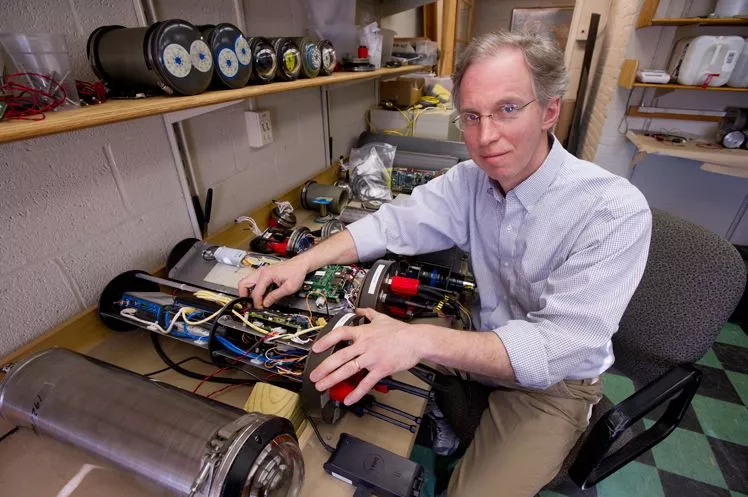It would definitely be an understatement to say that underwater research has its technical challenges. Remote-operated vehicles (ROVs) must be tethered to surface support vessels with unwieldy communications cables, deep-sea water samples have to be hauled to the surface for analysis ... or do they? Woods Hole Oceanographic Institution recently announced that it has partnered with two private companies, to market a couple of technologies that address both of those situations.
BlueComm
Previously publicized when it was still in development a couple of years ago, this system allows data to be optically transmitted through the water, and could conceivably replace the umbilical cables currently required by ROVs. Untethered ROVs wouldn’t need to be as big and powerful as current models (as they wouldn’t need to drag around all that heavy cable), which could in turn lead to smaller, more efficient surface support ships, and smaller crews on those ships.BlueComm utilizes low-power blue-light LEDs coupled with small, inexpensive optical sensors to send and receive coded light pulses through up to 200 meters (656 feet) of water. With a data transfer rate of 10 to 20 megabits per second, it could transmit streaming video from an ROV or seafloor sensor in almost real time.
Presently, data can be sent wirelessly underwater using acoustic signals, although those signals travel far slower than their optical counterparts, and their bandwidth is more limited – this makes them unsuitable for real-time control of ROVs.

With its current maximum range of 200 meters, BlueComm probably wouldn’t work for free-ranging deep-sea exploration. However, at locations where ROVs regularly dive (such as oil drilling or research platforms), a series of relay stations could be installed at 200-meter intervals.
It has also been suggested that out-of-surface-range seafloor sensors could optically transmit data to autonomous underwater vehicles, which would periodically make “fly-bys” to collect such information. That, or tethered optical communications packages could simply be lowered down to the sensors from ships every so often, a solution that would still be simpler than installing permanent sensor-to-shore seabed cables.
BlueComm has already been successfully demonstrated in a 2010 project, in which it was used to control an ROV that was installing equipment on the seabed at the Juan de Fuca Ridge in the Pacific Ocean. Woods Hole is now working with UK-based undersea communications firm Sonardyne International, to get the technology ready for the marketplace.
The Imaging FlowCytobot
Ordinarily, when scientists want to analyze the water from a given part of the ocean, they have to lower a sampling device off of a research vessel, allow it to collect an assortment of the microscopic plants and animals present in the area, haul it back up, and then manually assess their catch. The FlowCytobot eliminates some of those steps.It is still lowered to depth on a tether, but it then proceeds to detect, classify, measure and photograph phytoplankton and zooplankton on its own, while still submerged. That data is then transmitted back up to the support vessel, via a fiber optic cable within the tether. The system is low-powered and requires little maintenance, being able to remain submerged and transmitting 24 hours a day, for up to six months straight.

Needless to say, the FlowCytobot allows scientists to know what’s in the water much more quickly than would otherwise be possible.
Already, in 2007, a prototype version of the system detected the presence of a shellfish-poisoning toxic algae in the Gulf of Mexico. Local health officials were alerted, and responded by temporarily closing access to oyster and mussel beds. As a result, no cases of shellfish-related food poisoning occurred in the region.
The Imaging FlowCytobot is being commercially developed with oceanographic tech company McLane Research Laboratories.







